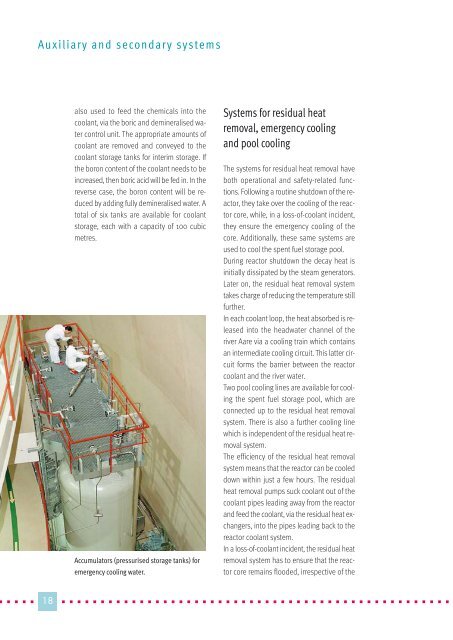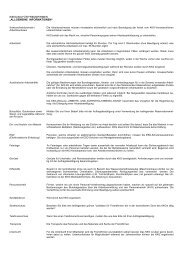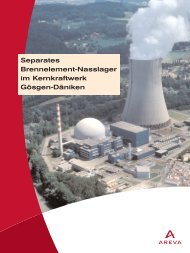Technology and Operation - Kernkraftwerk Gösgen
Technology and Operation - Kernkraftwerk Gösgen
Technology and Operation - Kernkraftwerk Gösgen
Create successful ePaper yourself
Turn your PDF publications into a flip-book with our unique Google optimized e-Paper software.
Auxiliary <strong>and</strong> secondary systems<br />
also used to feed the chemicals into the<br />
coolant, via the boric <strong>and</strong> demineralised water<br />
control unit. The appropriate amounts of<br />
coolant are removed <strong>and</strong> conveyed to the<br />
coolant storage tanks for interim storage. If<br />
the boron content of the coolant needs to be<br />
increased, then boric acid will be fed in. In the<br />
reverse case, the boron content will be reduced<br />
by adding fully demineralised water. A<br />
total of six tanks are available for coolant<br />
storage, each with a capacity of 100 cubic<br />
metres.<br />
Accumulators (pressurised storage tanks) for<br />
emergency cooling water.<br />
Systems for residual heat<br />
removal, emergency cooling<br />
<strong>and</strong> pool cooling<br />
The systems for residual heat removal have<br />
both operational <strong>and</strong> safety-related functions.<br />
Following a routine shutdown of the reactor,<br />
they take over the cooling of the reactor<br />
core, while, in a loss-of-coolant incident,<br />
they ensure the emergency cooling of the<br />
core. Additionally, these same systems are<br />
used to cool the spent fuel storage pool.<br />
During reactor shutdown the decay heat is<br />
initially dissipated by the steam generators.<br />
Later on, the residual heat removal system<br />
takes charge of reducing the temperature still<br />
further.<br />
In each coolant loop, the heat absorbed is released<br />
into the headwater channel of the<br />
river Aare via a cooling train which contains<br />
an intermediate cooling circuit. This latter circuit<br />
forms the barrier between the reactor<br />
coolant <strong>and</strong> the river water.<br />
Two pool cooling lines are available for cooling<br />
the spent fuel storage pool, which are<br />
connected up to the residual heat removal<br />
system. There is also a further cooling line<br />
which is independent of the residual heat removal<br />
system.<br />
The efficiency of the residual heat removal<br />
system means that the reactor can be cooled<br />
down within just a few hours. The residual<br />
heat removal pumps suck coolant out of the<br />
coolant pipes leading away from the reactor<br />
<strong>and</strong> feed the coolant, via the residual heat exchangers,<br />
into the pipes leading back to the<br />
reactor coolant system.<br />
In a loss-of-coolant incident, the residual heat<br />
removal system has to ensure that the reactor<br />
core remains flooded, irrespective of the<br />
� � � � �18 � � � � � � � � � � � � � � � � � � � � � � � � � � � � � � � � � � � � � � � � � � � � � � � � � � � �




